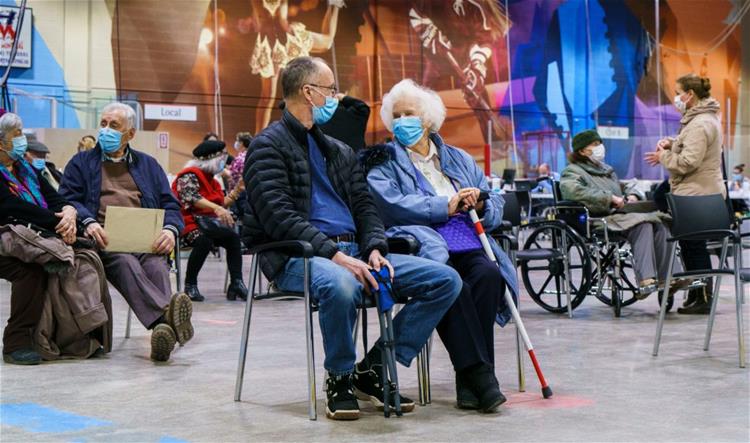
Seniors wait after receiving a first dose of the COVID-19 vaccine at a vaccination clinic in Montréal, in March 2021.
Published: April 28, 2021 | By Nicole Dalmer and Sally Chivers
The news surrounding COVID-19, especially when it comes to older adults, has been bleak.
Recent reports indicate heightened ageist attitudes towards older adults. News stories flag the deplorable living and working conditions in long-term care facilities, while older adults living at home seem to be forgotten. Older Asian women have been attacked in the streets of San Francisco and New York.
As critical age studies scholars, we deplore the negative attention older adults are receiving, when they should be seen as enriching our society and culture. We continue to search for different and better stories that highlight older adults volunteering at vaccine clinics, caring for their grandchildren so that parents can work and fighting back against damaging stereotypes.
Lately, though, as vaccine rollouts put older people first, news stories are changing.
News coverage is changing
Two news stories from the United States signal a change, but not in the way we’d hoped or expected.
In the first, two Florida women in their 30s and 40s visited a vaccination centre wearing “granny” outfits. They dressed up in bonnets, gloves and glasses to make themselves look older so they could jump the vaccine queue.
The second, describes Massachusetts’ vaccination strategy. The state trialled providing vaccinations to people who took individuals over 75 to their appointments. The intent was to help people who were having trouble getting to the clinic. This trial however attracted a trove of opportunistic people on the hunt for older adults to ensure they too could be vaccinated. As one Craigslist ad cited in the story reads:
“I have a great driving record and a very clean Toyota Camry. I can pay $100 cash as well. I am a friendly conversationalist and will allow you to choose the music and show me all the pictures of your grandkids!”
Is buddying-up crossing the border?
In Canada, stories of age fraud and the benefits of buddy strategies haven’t hit the news. But the prioritization of vaccines for some over others continually reorients which bodies have value, why and in what context.
As Alberta and Ontario leaked the news that they would be lowering the eligibility for AstraZeneca vaccines from 55 and older to 40 and older, Twitter feeds devoted to connecting people to available doses counselled how to get around the birth date section of the online form to gain a cherished appointment as quickly as possible.
While birth year remains the primary criteria for vaccine eligibility in Canada, factors such as Indigeneity, living in a hotspot or working as a special education teacher also affect who is in the line up and where.
From liabilities to hot commodities
Older adults are framed as liabilities both before the pandemic, and now. Assumed to be in a constant state of being at risk — both for themselves (at risk of falls, frailty, memory lapses, and now, contracting COVID-19) and for jeopardizing public spending. The mindset is that we just can’t afford an aging population, but somehow we’re stuck with it.
The two news stories out of the U.S. appear to push back against the prevailing story of older adults as risky liabilities. These stories signal a shift, showing how older adults have gained currency as vaccines roll out, however slowly or chaotically. Because being of a certain age grants early, or earlier, access to COVID-19 vaccines, a lower birth year has become a hot commodity. This shift has consequences that we cannot ignore.
The aging enterprise
The stories we have highlighted are just a small example of a crucial shift in how the aging enterprise operates.
Carroll Estes, renowned gerontologist, whose critical thinking and writings about social policy and the political economy of aging are foundational to the field of gerontology, developed the concept of the “aging enterprise.”
The aging enterprise includes the complex web of professionals, organizations, programs, media, service providers and trade associations (among others) that benefit (often financially) from ensuring that older adults’ needs are both processed and treated as a commodity (often sold for a profit). But now, with vaccine rollouts based on age, it’s not older adults’ needs, but their very bodies that are treated as commodities — commodities that might help younger people gain access to those coveted COVID-19 vaccines.
We agree that older people have value. We’ve staked our careers on it. We also agree with Estes that we must dismantle the aging enterprise, not shift it.
Estes argues that how we age is affected by messages in the media and research, as well as how policies frame older adults. For once, we have policy coherence as older adults are prioritized for vaccines in most countries and regions. And yet scarcity rears its ugly head to turn that prioritization into an opportunity for hoaxers and exploitation.
So, instead of buddying-up with someone eligible for a vaccine just to get ahead of the line, dressing up as a caricature of a granny or faking your birth date to get to the next page of an online form, it’s worth paying attention to who is making the decisions about who gets the jab and on what basis.
Now, there is a golden opportunity to revalue groups of people who have consistently ended up on the margins, based on colonialism, occupation or age.
Nicole Dalmer, Assistant Professor in the Department of Health, Aging and Society, McMaster University and Sally Chivers, Professor of English and Gender & Women’s Studies, Trent University. This article is republished from The Conversation under a Creative Commons license. Read the original article.

